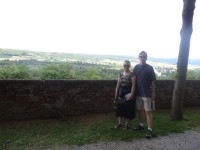 By far the main thing to see in Melk is the abbey. It dominates the town. It is simply huge at over one thousand feet long, and it is brilliantly painted yellow so it can be seen for miles around. There has been some abbey here since around 1100, and the current form of the abbey is about 300 years old. It was the main reason I wanted o make sure I had a day to be in charge while we were in Melk – I really wanted to tour the abbey.
By far the main thing to see in Melk is the abbey. It dominates the town. It is simply huge at over one thousand feet long, and it is brilliantly painted yellow so it can be seen for miles around. There has been some abbey here since around 1100, and the current form of the abbey is about 300 years old. It was the main reason I wanted o make sure I had a day to be in charge while we were in Melk – I really wanted to tour the abbey.
It did not disappoint. After a hearty climb up (and up) to the clifftop where the abbey stands, we entered the first courtyard where we bought tickets to a guided tour (in English). We had a few minutes before our tour started, so we strolled through the manicured English-style garden until our tour was ready. We had a large group of about thirty people, and we had a great enthusiastic guide who spoke excellent English.
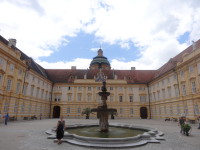 She took us into the main courtyard of the abbey, where she pointed out the modern paintings of the four virtues – wisdom, courage, justice, and temperance. She also pointed out where the abbey school was, were nine hundred local students attend school for only about one hundred dollars per month (teacher salaries are paid by the Austrian government).
She took us into the main courtyard of the abbey, where she pointed out the modern paintings of the four virtues – wisdom, courage, justice, and temperance. She also pointed out where the abbey school was, were nine hundred local students attend school for only about one hundred dollars per month (teacher salaries are paid by the Austrian government).
She then took us into the abbey museum, which was laid out chronologically. It started with the oldest objects in the abbey (a portable alter from about 1100) and worked forward, with each room roughly corresponding to an age. At the high point of the abbey (around 1600 during the Counter-Reformation), the abbey had state backing and about eight hundred resident monks. It now houses about thirty working monks, with other monks associated with the abbey serving parishes around the area.
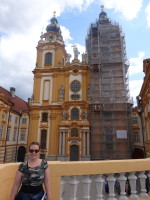 Joseph II, the son of the great queen Maria Theresa, was tolerant of other religions, and officially allowed Protestants, Jews, and Orthodox Christians back into Austria, and the abbey lost at least a little state support during the time. On display from the time was Joseph II’s plan of a reused casket where the body was dropped out of a bottom that opened in the casket. It was hugely unpopular and was no longer used after a few years.
Joseph II, the son of the great queen Maria Theresa, was tolerant of other religions, and officially allowed Protestants, Jews, and Orthodox Christians back into Austria, and the abbey lost at least a little state support during the time. On display from the time was Joseph II’s plan of a reused casket where the body was dropped out of a bottom that opened in the casket. It was hugely unpopular and was no longer used after a few years.
The tour took us out to the balcony overlooking the Melk River (which we had mistakenly thought was the Danube, which is much bigger and nearby), with some amazing views. We also had close-up views of the facade of the beautiful church of the abbey. The tour continued, and ended, in the library of the abbey, which is still an active library where researchers come to read.
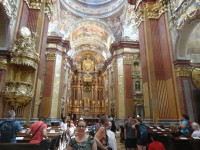 After the tour, we went into the church, which is the most gilded (covered in gold) church I have ever seen. It was jaw-dropping when we first walked in. We entered the church at 11:55, and they have a short prayer service at noon, so we stayed for that. We did not understand the German, but we knew the English version of the song they sang, so we attemped to sing the German words which we had to read. We also knew the scripture reading from John 21 was about Jesus restoring Peter to his position (the “Feed my sheep” passage), so we got the gist of that.
After the tour, we went into the church, which is the most gilded (covered in gold) church I have ever seen. It was jaw-dropping when we first walked in. We entered the church at 11:55, and they have a short prayer service at noon, so we stayed for that. We did not understand the German, but we knew the English version of the song they sang, so we attemped to sing the German words which we had to read. We also knew the scripture reading from John 21 was about Jesus restoring Peter to his position (the “Feed my sheep” passage), so we got the gist of that.
After the service, we wandered around the church, which had two skeletons decked out in fine clothing in tomb niches – they were unknown Christians, but were very old. The church also has the remains of the saint of the church, St. Coloman, who was mistakenly hanged as a Hungarian spy in 1012 AD.
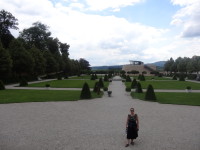 We finished our tour of the abbey by going back to the gardens, but spending more time there. We wandered though well-kept paths in a small but dense forest, looked at the herb garden, and walked though a long vine-covered arbor. The gardens were quiet and soothing.
We finished our tour of the abbey by going back to the gardens, but spending more time there. We wandered though well-kept paths in a small but dense forest, looked at the herb garden, and walked though a long vine-covered arbor. The gardens were quiet and soothing.
I was very pleased with our tour of the abbey – certainly an “A” for touring. We went back to our room and I planned the afternoon. I wanted to see various sights around Melk, for which I took advice from the internet. As it turns out, I got an “A” for effort, but really only a “B” for results – interesting drives, with nice and pleasant places on the far end, but no real must-see attractions.
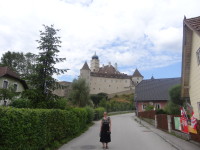 We started the afternoon going to nearby Schloss Schönbühel (Schloss means “castle”). It looked really cool from internet pictures, so I was excited to see it. It turns out it is a private residence. What private citizen owns a whole castle, and not a small one at that? Clearly, it is some mastermind planning a lair. So, while impressive and pretty, it was a bit of a strike out.
We started the afternoon going to nearby Schloss Schönbühel (Schloss means “castle”). It looked really cool from internet pictures, so I was excited to see it. It turns out it is a private residence. What private citizen owns a whole castle, and not a small one at that? Clearly, it is some mastermind planning a lair. So, while impressive and pretty, it was a bit of a strike out.
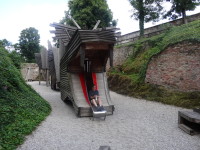 We next headed inland away from the river to Schloss Schallaburg, which is happily open to the public. Unhappily, we got there at 4:00 and it closed at 5:00. Still, there was a certain rush to racing though the castle and grounds with no map and no audio guide, trying to see it all. I think we did see all the places open to the public, although we blew through the dozen or so rooms that had a museum exhibit dedicated to the 1970’s – I will admit it was strange seeing a Darth Vader outfit in a museum display. We found and loved the castle playgound, which was a large wooden dragon with things to climb and slides to play on. It was brilliant. This was a better stop, but the timing was a tad poor given that we only had about forty-five minutes to see things.
We next headed inland away from the river to Schloss Schallaburg, which is happily open to the public. Unhappily, we got there at 4:00 and it closed at 5:00. Still, there was a certain rush to racing though the castle and grounds with no map and no audio guide, trying to see it all. I think we did see all the places open to the public, although we blew through the dozen or so rooms that had a museum exhibit dedicated to the 1970’s – I will admit it was strange seeing a Darth Vader outfit in a museum display. We found and loved the castle playgound, which was a large wooden dragon with things to climb and slides to play on. It was brilliant. This was a better stop, but the timing was a tad poor given that we only had about forty-five minutes to see things.
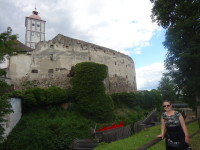 I then drove over to the north side of the Danube, and followed some winding roads to the town of Maria Laach, which was supposed to be beautiful. It turns out that is true, and the very pretty church was still open, even at 5:30, (as an aside – another tiny town with an amazing church!) but the town was mostly a small number of pretty homes surrounded by flowers, surrounding the church. It was pretty, but there was little to do or see. The cowpath we had to drive out of town made up some adventure, but the stop still seemed slightly disappointing.
I then drove over to the north side of the Danube, and followed some winding roads to the town of Maria Laach, which was supposed to be beautiful. It turns out that is true, and the very pretty church was still open, even at 5:30, (as an aside – another tiny town with an amazing church!) but the town was mostly a small number of pretty homes surrounded by flowers, surrounding the church. It was pretty, but there was little to do or see. The cowpath we had to drive out of town made up some adventure, but the stop still seemed slightly disappointing.
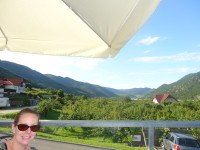 We followed the cowpath, with a few close encounters with oncoming cars, to the town of Willendorf, where we had supper on a patio overlooking the hills of the area and the Danube river. Our server, who also may have been the owner, spoke good English and had a dry sense of humor, and the nice weather made al fresco dining a delight. This redeemed the afternoon quite a lot as we ate a leisurely meal in a pretty place.
We followed the cowpath, with a few close encounters with oncoming cars, to the town of Willendorf, where we had supper on a patio overlooking the hills of the area and the Danube river. Our server, who also may have been the owner, spoke good English and had a dry sense of humor, and the nice weather made al fresco dining a delight. This redeemed the afternoon quite a lot as we ate a leisurely meal in a pretty place.
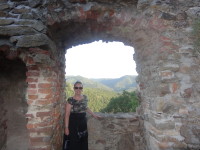 The last stop of the evening was to go back to Melk where we could cross the Danube, and drive up the south side to more or less Willendorf, but on the other side. We drove up and up another paved cowpath to get to some castle ruins, Burg Aggstein. It was late enough (about 8:00) that the high existing parts of the castle were locked and closed, but we could still wander around the lower levels. That was good, and the views we could see of the Danube and valley were tantalizing, but it was obvious the real views were up in the locked towers. I told Meredith it felt like the Dance of the Seven Veils of tourism, but we had only seen two veils. So, another slight letdown, but the evening air was fine and the drive was pretty back to Melk.
The last stop of the evening was to go back to Melk where we could cross the Danube, and drive up the south side to more or less Willendorf, but on the other side. We drove up and up another paved cowpath to get to some castle ruins, Burg Aggstein. It was late enough (about 8:00) that the high existing parts of the castle were locked and closed, but we could still wander around the lower levels. That was good, and the views we could see of the Danube and valley were tantalizing, but it was obvious the real views were up in the locked towers. I told Meredith it felt like the Dance of the Seven Veils of tourism, but we had only seen two veils. So, another slight letdown, but the evening air was fine and the drive was pretty back to Melk.
So, tomorrow we move east again, aiming to get to the town of Badden, where there has been a bath/spa since Roman times.
One guess what “Badden” means… 😉
I had assumed “bath.” Why?
I was being tongue-in-cheek. Yes, it means “bath”.
Never assume I know ANYTHING in German, so tongue-in-cheek is lost on me.